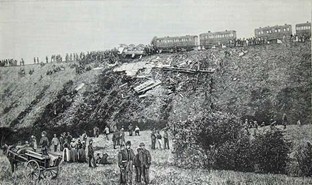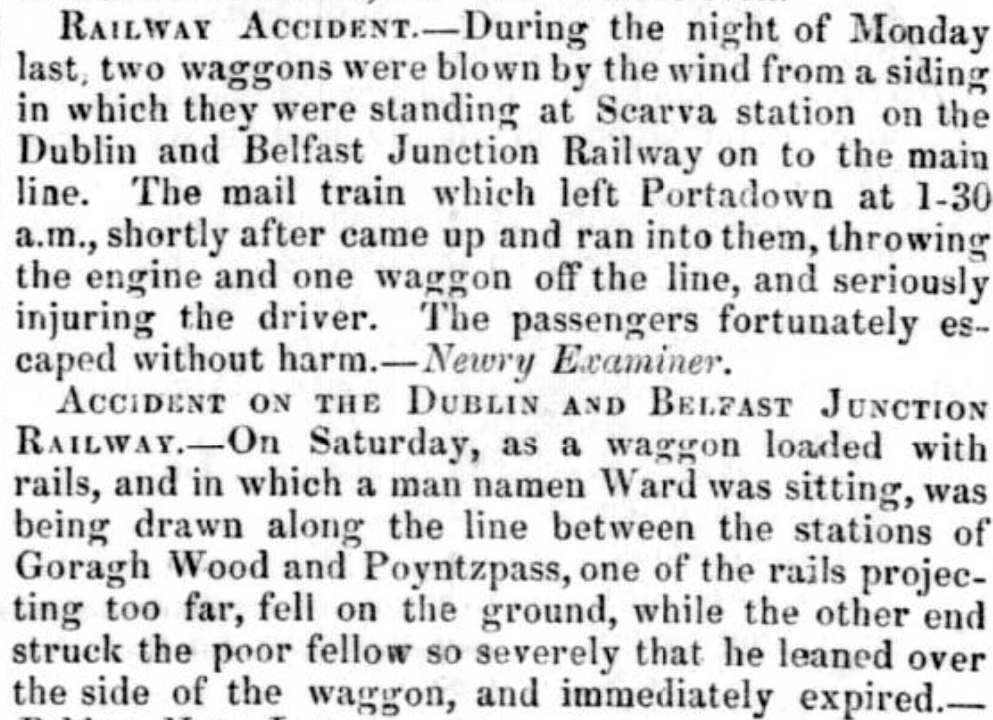Deaths Come Quickly
Accidents, casualties and fatalities in the operation of this new-fangled means of transport were not long in coming. The first railway death near Poyntzpass came before the track was even open for scheduled services.
On 17th September 1851, a young brakeman called Robert Downey fell between two wagons, across one rail. He was immediately run over by 10-12 wagons, and his body was completely severed at the waist.
It took some time for the public to realise just quite how dangerous venturing onto the railway tracks could be. One of the earliest fatal accidents due to trespass occurred in Poyntzpass when, on 13th October 1853, an unnamed man was killed by a passing train.
Vandalism, too, made an early appearance. It was reported in April 1852 that twice in the previous two months, large sections of the D&BJR track near Dromantine had been “torn up”. To what end? Did someone have a grudge?
May 1853
The Armagh Guardian reported:
“…a special train conveying two of the Directors…met with an accident which might have been attended with very serious and fatal consequences. The train consisting of an engine, tender, first class carriage and luggage van…was approaching the Poyntz-pass station, and the pointsman stationed there was standing at his post with the point in his hand.
Just as the engine had got across the points, he suddenly reversed them, and the tender carriage etc ran off the line, of course. The carriage was very much injured, but, fortunately, the Directors escaped without receiving any injury. What could have induced the pointsman to do such a stupid thing remains a mystery. He was at once arrested and lodged in gaol, to await the decision of the authorities on his conduct.”
June 1886
The 2.30pm southbound train from Portadown left the tracks suddenly after travelling about two miles, probably due to the track having bucked in the heat. Four carriages fell on their sides; five people were killed and about 25 gravely injured.
June 1989 – The Armagh Railway Disaster
12th June 1889 was the darkest day in the history of Irish railways, when the Armagh railway disaster happened.
Armagh Methodist Sunday School had organised an excursion to Warrenpoint; thorough a series of misunderstandings, the engine provided was not sufficiently powerful to haul the unusually long train’s fifteen carriages, with 800 adults and children on board, up the steep gradient outside the city.

The railway staff stopped the overloaded train on the hill, put stones under the wheels of the rear ten coaches, and uncoupled the engine and front five coaches, planning to take the coaches to Hamiltonsbawn station.
But in doing so, they bumped the rear portion of the train, dislodging the stones, and it ran backwards towards Armagh station. It collided with a scheduled train coming up the same track, and the rearmost two carriages were completely destroyed and a third badly damaged.
80 people (many of them children) were killed and 260 were injured. The disaster led to far-reaching changes in railway safety regulations throughout the British Isles, covering operating procedures, signalling, and physical safety measures such as brake system design; future brakes had to be on by default, instead of off, and would therefore be applied automatically if the braking system was damaged or power lost.
Other Individual Fatalities
Over the years, newspapers carried many more reports of individual fatalities on the Dublin-Belfast line in the vicinity of Poyntzpass, many involving railway company employees, and often also, perhaps predictably, featuring alcohol.
January, 1861
Two accidents occurred locally within the space of a few days, one of them fatal.

July 1869
The Newry Examiner reported:
“It appears that a railway porter, named Samuel Henry, was walking from Scarva station to that of Poyntzpass. On the line, which he considered the shortest way to accomplish the journey, he was met half way by the express night mail from Dublin, and knocked down, the whole train passing over him. He was, of course, instantly killed.”
August 1896
Deaths weren’t confined to the tracks. On 23rd August, the night mail train from Derry to Dublin experienced a long delay outside Poyntzpass because the signals were against it. The fireman left the cab to investigate, and found Owen McCreesh, aged 30, dead on the floor of the signal box.
May 1897
“A shocking fatality occurred on the Great Northern Railway line, about three-quarters of mile from Poyntzpass Station… A young man named John Baird, farm labourer, of about 16 or 17 years of age, living with a farmer named Felix Cassidy, in the townland of Aughantaraghan, was returning home at about 10.30pm, and on crossing the line to the house in which he is employed, and which is situate close to the railway, was knocked down by the mail train which leaves Dublin at 8.20pm.
The driver (John Traynor) felt a slight shock, and consequently examined his engine at Scarva (the first station ahead for stopping), and found some particles of broken bottle in the fire-box. When the mail arrived in Portadown, the driver or fireman in the act of oiling the engine perceived particles of flesh and blood adhering to the wheels of the tender of the locomotive. Both driver and fireman immediately returned with the engine to Poyntzpass and aroused Sergeant Ewing, of the Royal Irish Constabulary, who proceeded to the place on the line where the shock was felt, and there found the mangled remains of the deceased young man, with the head and arms completely severed from the body and mutilated beyond recognition.
November 1908
Another case was that of Patrick McAtamney, 37, of Aughantaraghan, a ‘surfacer’ employed by the GNR. The Newry Reporter recorded that on 7th November he was “cut to pieces” by the Greenore Express just outside Poyntzpass station. An inquest was held on 10th November in the Ladies Waiting Room of the station. He appears to have been taking a short cut home to his “humble little home…and wife and one child” while drunk. There were gruesome newspaper reports of body parts and limbs being found on the trackside and on the undercarriages of some coaches.
August 1915
Another gruesome death occurred on 14th August. A ganger called Alexander Minnis finished his shift in the early afternoon and walked through the station along the track, heading home. Shortly afterwards, on a curve north of the station, the driver of a cattle ‘special’ briefly spotted him stooped beside the track with his head close to the rail, as if examining it. Unable to brake in time, the train passed over him. Dr MacDermott pronounced the cause of death as “destruction of the brain”.
September 1927
On 22nd September, Robert Moody, aged 19 and a porter at the station, was killed by a train when crossing the tracks to get to the lamp store.
July 1992
In July 1992, Mark Magill aged 22 was killed when a Belfast-bound train hit his car at the unmanned McVeigh’s crossing near the village and just 100 yards from his home; the train was partially derailed.
Goraghwood Quarry
Goraghwood Quarry, which supplied ballast for the track, right from the time the D&BJR was built, was one of the most dangerous working environments in the area. There are multiple newspaper reports, through the decades, of quarry workers being killed and injured – from unexpected detonations, being hit by flying rocks from blasting operations, falling to their death or being crushed by rock piles collapsing.